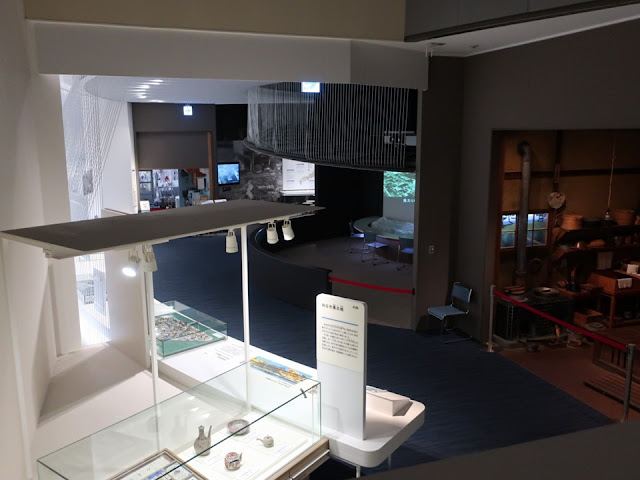The museum is very unique, because there are no explanation panels and are full-scale models. We watch and think, however we can access to the explanation with our smartphone and volunteer guides help us. The full-scale models make us realize the atmosphere in the past. Moreover, the admission fee is free (when I visited).
Yokkaichi City, which is near Nagoya (the
largest city in central Japan), suffered from air pollution in 1960s. The museum
has an exhibition room which focuses on the pollution problem. I’ll also show
you Kuwana which was the next post town of Yokkaichi in the Edo period (1603~1868), and Miya post town which was
the next one of Kuwana.
The towns in the medieval and the Edo periods are rebuilt. We can walk the street.
中世と近世の四日市が実物大で作られています。この通路を歩けます。
実物大模型があり、説明板がない! 見て考える、とても面白い博物館です。説明にはスマホでアクセスできます。ボランティアガイドさんもいるそうです。しかも、全て無料(訪問時)。かつて、大問題になった公害にもしっかり目を向けています。隣の桑名宿、船で渡った名古屋の宮宿とともに紹介します。
At the entrance of the exhibition room, Yokkaichi City is explained by the video. The city has been a logistic and traffic hub.
展示室に入ると、まずは、スクリーンで四日市の説明。物流の拠点、交通の要所ですね。
There is a full-scale model of an ancient house. A dog is a member of the family, captured birds are hung and smoked; it’s so real.
弥生時代は、久留部村と呼ばれていました。平安時代まで続いたという竪穴住居での暮らしの実物モデルがあります。犬がいる、獲物の鳥を吊しているなど、ホームドラマのようにリアルです。
Yokkaichi Market、四日市の市
The market around 500 years ago was rebuilt. “Yokka-ich” literary means “The fourth day market”; the market was opened on the 4th, 14th and 24th of every month. It says, “Imagine the busy market. Let’s think where the products came from, where they went to, how they were used and so on.” The intention of the curator is very clear.
The photo below shows shops which sell seafood, fabric and crafts. The pillars are raw lumbers because it’s a temporary use.
500年前の中世の市が再現されています。四日、十四日、二十四日に立つ市なので四日市なのですが、「人々で賑わう市のようすや、品物がどこから来て、どこへ行き、どう使われたのかなどを、ゆっくりと想像してください。」と書かれています。学芸員さんの展示の意図がハッキリ示されていますね。
下の写真は、海産物、木製品、布の販売店です。仮設の店なので、木を加工せずに柱にしています。
Yokkaichi post town on the Toukaidou (highway) in the Edo period、江戸時代の東海道四日市宿
The photo above is an inn. The boards beside the stairs on the left mean that the inn is the certificated member of the quality inn groups (Naniwa-kou and Kantou-kou). It’s an elaborate exhibit. However, the tub for washing foot is a bit small; no problem.
食事を出す宿である旅籠の模型。階段の横には、優良認定旅館の印である浪花講、関東講の札が掲げられています。丁寧な展示です。でも、足を洗うタライは小さいかな。
The dinner is set at the guest room behind. It's one of the most fun times during travel.
奥の客間には料理が置かれています。旅の一番の楽しみですね。
The restaurant above serves baked clams which are specialty of the area.
焼き蛤の店。桑名宿の名物かと思いきや、桑名には焼き蛤はなく、四日市宿と桑名宿の間の宿、小向と富田で売られていたそうです。
There was a saying that we could prevent from clam poison if we baked them by pinecone instead of charcoal. The scent of baked clams and pinecones attracted travelers. We should try specialties.
炭の代わりに松ぼっくりを使うと貝にあたらないという言い伝えがあったそうで、松ぼっくりと、その周りに置いた蛤が焼ける香りが旅人を誘いました。名物は、食べないとね。
The guest sits on the floor and the waitress is serving baked clams. The models were made well!
人も小道具も良く出来ています。
In Toiyaba or the post-town management office, the rate sheet is displayed. It shows the price to carry luggage or traveler or both to the next post town by horse or worker. It’s clear and honest. The officer sits on the stage in order to check the state of the logistics.
The exhibition is named “Ji (time) Ku (space) Kaidou (highway)”. It is written, "You can feel the flow of the history. You can also feel the changes of day and night, and it of season; the video, lighting and small exhibits work to do so." I agree, I could enjoy passing through space and time.
問屋場には、隣の宿までの料金を記載した表を貼っていました。小柄でいかにも国産馬という荷駄もいます。明朗会計ですね。責任者は見通しが良い高いところに座っています。
この展示は、「時空街道」と名付けられています。「歴史の流れを感じられるほかに、昼と夜の変化や季節の移り変わりを、映像や照明、小道具などで演出しています」と書かれています。納得です。
Modern period、明治以降
The exhibition room is named “Yokkaichi Pollution and Environmental Museum for Future Awareness”. The industrialization caused the serious public pollution here, because many chemical plants were built. The declaration says, “We never forget that citizens, companies and governments tackled together to improve our environment. We will proceed to build a city which harmonizes with our environment.”
「四日市公害と環境未来館」として、近代以降の展示がされています。産業化に伴い、深刻な公害を経験したこと、そして、市民・企業・行政が一体となって取り組んで環境を改善したことを忘れず、都市と環境が調和したまちづくりをすすめる、ということを「誓いのことば」として掲げています。
Outbreak of environmental pollution; it was the terrible byproducts to get material wealth.
公害の発生。物質的な豊かさを追求したことの弊害でした。
Yokkaichi people improved their environment. Without rich and wholesome nature, we cannot enjoy our lives, I think.
環境を改善した四日市市。豊かで健全な自然なくして、楽しい暮らしはないと思います。
The museum is at the 2nd and the 3rd (entrance) floor of the complex “Soranbo” which also has a planetarium.
プラネタリウムもある複合施設「そらんぽ」の二階と三階に博物館があります。
To the neighboring post town “Kuwana”、桑名宿へ
I drove on the old Tokaidou highway. There is a small museum about Yokkaichi post town on the left. I usually travel on weekday because it’s not crowded. But, it was closed because of weekday.
四日市から旧東海道を桑名宿へと向かいました。旧道に、資料館がありましたが、休館。平日の旅は、小さな資料館が休館になっているのがネックです。
Old ferry pier site of Kuwana: it was a sole sea route in old Toukaidou highway which linked Kyoto and Edo (old name of Tokyo). The ferry linked to Miya post town in Nagoya, which was in front of Atsuta Jingu (shrine, miya). Banryu turret of Kuwana Castle welcome us.
桑名宿・七里の渡跡:熱田神宮前の宮宿と船で結ぶ東海道唯一の海路でした。桑名城の蟠龍櫓(ばんりゅう)が出迎えてくれます。桑名城は城跡のみです。
七里の渡の鳥居は、伊勢参宮名所図会にも描かれています。多くの旅人が行き来したと思うと、感慨深いですね。鳥居の向こうにある町には、うどんで有名な「歌行燈」など料理屋さんが並んでいます。
Miya post town in Nagoya、宮宿(名古屋)
The photo above shows the ferry pier. It takes only fifteen minutes to Atsuta Jingu by walk.
こちらは、七里の渡、宮宿の船着き場。熱田神宮へは徒歩15分ぐらいです。「宮」は熱田神宮ですから。
There is an ex-inn building “Iseya” in front of the pier. It was a certificated inn (waki honjin) which high-ranking people stayed.
船着き場の前には、脇本陣格の旅籠屋「伊勢久」さんの建物が残っています。
Visited
in December, 2021
Official
website: https://www.city.yokkaichi.mie.jp/museum/museum.html (in Japanese), accessed in
June, 2022
Previous post (Large castle palace in
Nagoya): Nagoya Castle、名古屋城
Next post (Museum on the same highway /Toukaidou): Chiryu history and folklore museum、知立市歴史民俗資料館





















Comments
Post a Comment